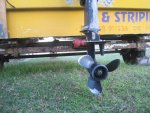Hi All
I bought a flat bottom to run in a very shallow inlet, well parts of it. To get in and out of the rivers and out to the mouth you sometimes have to chop through (or drag it) water that is about a hand deep.
I have attached some pics of the boat and the motor as it is. I think the motor can come up about 8cm until the cavitation/ventilation plate is level with the back of the boat.
The person who is making the plate is asking me how much i want to go up with to start off with and how much set back. I was going to request 8cm of uplift to start (the plate will have 15cm of adjustment up) to put the cavitation plate level with the back of the boat.
I quite often/always have to tilt the motor and chop in at low speeds whick can take a few minutes.
The inlets levels can vary with the tides and if the bar is open/closed to the inlet.
Any ideas how far i should request the setback? The boat planes well atm.
I need to be able to run this motor and boat in the shallowest possible water, any info of low water intakes would be appreciated. I do often bounce the motor and the hull across the sands and weed.
I bought a flat bottom to run in a very shallow inlet, well parts of it. To get in and out of the rivers and out to the mouth you sometimes have to chop through (or drag it) water that is about a hand deep.
I have attached some pics of the boat and the motor as it is. I think the motor can come up about 8cm until the cavitation/ventilation plate is level with the back of the boat.
The person who is making the plate is asking me how much i want to go up with to start off with and how much set back. I was going to request 8cm of uplift to start (the plate will have 15cm of adjustment up) to put the cavitation plate level with the back of the boat.
I quite often/always have to tilt the motor and chop in at low speeds whick can take a few minutes.
The inlets levels can vary with the tides and if the bar is open/closed to the inlet.
Any ideas how far i should request the setback? The boat planes well atm.
I need to be able to run this motor and boat in the shallowest possible water, any info of low water intakes would be appreciated. I do often bounce the motor and the hull across the sands and weed.





















